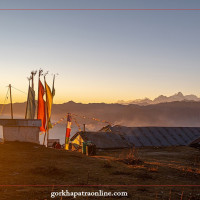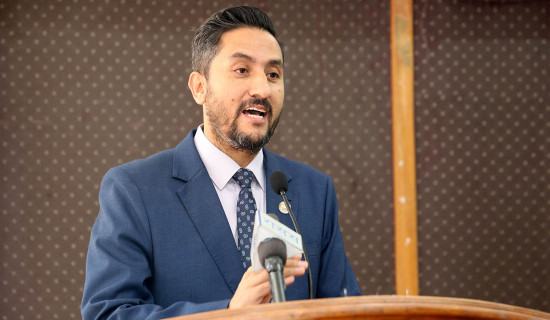- Wednesday, 17 December 2025
Accident statistics show need to split and adequately staff CAAN
By Aashish Mishra,Kathmandu, Jan. 22: We have had 22 complete years in the 21st century so far. Yet, in these years, Nepal has seen 34 aviation accidents, according to the Aviation Safety Network, the website that keeps track of aviation accidents, incidents, and hijackings all across the world.
According to the data maintained by the Civil Aviation Authority of Nepal (CAAN) in its Aviation Safety Report 2022 too, Nepal had an aircraft accident in every year of the past decade except for 2021. From 2012 to 2022, CAAN recorded 26 incidents involving planes and helicopters registered in Nepal. Of them, 16 were fatal.
And, just 15 days into 2023, the country saw yet another plane crash: an ATR-72 belonging to Yeti Airlines and having the call sign 9N-ANC crashed into the Seti Gorge near the new airport in Pokhara at 10.50 am last Sunday in flight from Kathmandu. It had 72 people, including four crew members, on board, 71 of whom are confirmed to have died, making this the worst aviation accident involving a domestic airline in Nepal’s history.
The accident, which occurred on the day of the Nepali festival of Maghe Sankranti, has raised a lot of questions because it was flying in clear weather on a route and in an aircraft widely considered safe in a city that had not seen a plane crash in 20 years while approaching a modern airport inaugurated only two weeks ago.
“This demands a thorough investigation,” said Sriram Sharma Baral, a retired senior captain who served as a pilot for 36 years with the national flag carrier Nepal Airlines Corporation (NAC). “The plane appears to have been flying lower than is normal for the approach it was seemingly making,” he said, referencing a video currently circulating on social media that shows the plane above some residential buildings moments before it crashed.
“Planes do not just drop out of the sky and pilots are extensively trained to handle emergencies,” said Baral, who was recognised for safely landing an NAaC Dakota aircraft in Nepalgunj in the 1970s despite its landing gears failing to deploy. However, he cautioned against making speculations until the probe committee formed by the government completed its investigation.
Sunday’s tragedy also sparked public outrage, most of which has been directed at Yeti. Because the last deadly crash that happened seven months ago, in which a Tara Air DHC6 aeroplane crashed in Mustang killing all 22 on board, was also associated with it (as Tara Air is a subsidiary company of Yeti Airlines). It was the first domestic air crash since 2016 that killed more than five people. And that 2016 air crash was also of a Tara Air flight that fell out of the sky at Dana, Myagdi and killed 23.
In fact, a Yeti or a Tara Air plane has been meeting with an accident every two to four years since 2001.
“These are alarming numbers that point to a systemic problem within an airline company,” said Sanjiv Gautam, former director general of CAAN. “This must be thoroughly looked into.”
Sudarshan Bartaula, spokesperson for Yeti, also acknowledged the grim picture the statistics painted and said that the airliner took the matter seriously. “We are a company that have been flying for over 24 years. And in that time, we have admittedly recorded more accidents than some of the newer airlines which have not been in operation as long as we have.”
Bartaula stressed that Yeti was committed to ensuring the safety of its passengers and complied with all the necessary regulations.
Then, why the repeated accidents and why this week’s disaster, which occurred without the seeming presence of any of the factors traditionally blamed for air crashes in Nepal? “We are determined to find out,” he answered, sharing that the carrier had formed an internal committee to analyse the recent painful incidents, identify weaknesses and take corrective actions.
CAAN: Understaffed and overworked But the almost yearly accidents also cast doubt on CAAN and its institutional capacity to ensure aviation safety. “The Authority is understaffed and overstretched,” Gautam, who headed the country’s chief civil aviation agency from 2015 to 2019,” said.
“CAAN has difficulties recruiting and retaining employees because trained personnel get better pay and facilities in the private sector,” he said.
This is a problem the Authority has admitted to in its recruitment plan report published last year. The report states that CAAN requires 1,122 qualified personnel to meet its “enlarged role as regulator and to strengthen its safety oversight capability.” But, as of mid-July 2021, it only had 815, with 307 positions lying vacant.
Similarly, with an annual retirement rate of three per cent, CAAN estimates that 14.6 per cent of its total workforce will retire by the fiscal year 2024/25 – workforce it is having trouble replacing due to “non-availability of adequately qualified manpower pertaining to different specialised areas of aviation in the local market” and other reasons.
But Jagannath Niroula, spokesperson for CAAN, insisted that the short age of staff had not hindered the body from executing its duties. “Our recruitment process is outlined by the Public Service Commission (Loksewa) and we also hire people on a contract basis to fill our manpower deficit.”
CAAN is legally mandated to be the regulator of civil aviation as well as the service provider in the areas of air navigation services and aerodrome operations “and we will always fulfil all these responsibilities,” Niroula assured.Time to split However, that is part of the problem, Gautam highlighted.
“This dual role of regulation and service is perceived as a potential conflict of interest,” he said. The European Union (EU) has remained particularly apprehensive and, despite initially appearing positive and acknowledging the above-global average effective implementation score obtained by Nepal in its International Civil Aviation Organisation (ICAO) safety audit conducted in April last year, continued its decade-long ban on all Nepali carriers through the EU Air Safety List updated in November.
As per international norms, the same aviation body cannot be in charge of enforcing rules and providing services and the EU has long asked the Government of Nepal to implement the commitment it made in 2009 to split CAAN into two separate entities to handle these two tasks.
Similarly, in the aforementioned safety audit, Nepal scored nearly 30 percentage points less than the global average on organisation and accident investigation, the former of which also hints at the need to divide CAAN up, Gautam said.
After years of discussions and delays, two bills – the Civil Aviation Authority of Nepal Bill and the Air Service Authority of Nepal Bill – were finally presented to and endorsed by the National Assembly in 2020 and 2021 respectively. However, they stalled when they reached the House of Representatives. The previous House was dissolved without passing them and the new House has not yet picked them up for endorsement.
For the time being, as noted in the recruitment report and documents CAAN provided to the European Commission in a meeting on November 10, 2022, the Authority has adopted regulations to set up a functional separation between its regulatory and service-providing wings and stop the cross-transfer of staff.
The Europeans, though, as evidenced by the sustained prohibition, do not seem convinced.
The latter score, relating to accident investigation, demonstrates the need for an independent accident investigation and follow-up bureau. “Currently, accidents are investigated and recommendations are forwarded, but there is no sustainable mechanism to ensure those recommendations are followed through,” Gautam said.
“This leaves the door open for future accidents of similar nature.”
“We need an autonomous body to ensure proper compliance,” he emphasised.
Following the latest crash, the National Human Rights Commission has also called on the government to implement national and international suggestions and meet global standards of safety.
Meanwhile, the EU has postponed the on-site assessment visit to Nepal it had planned for this year to reconsider whether or not to lift the ban on Nepali airline companies.
Furthermore, with regard to the Pokhara accident, everyone The Rising Nepal spoke to stressed the need to refrain from making assumptions and pointing fingers and let the probe committee work and deliver its findings.






-original-thumb.jpg)
-square-thumb.jpg)








